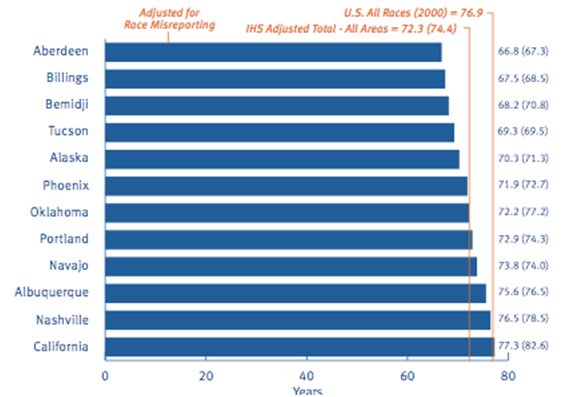Measuring the progress in native health – life expectancy for Native Americans
Has the Indian Health Service been an effective, government-run delivery system?
Consider this from a White House memo: “While there has been improvements in health status of Indians in the past 15 years, a loss of momentum can further slow the already sluggish rate of approach to parity. Increased momentum in health delivery and sanitation as insured by this bill speed the rate of closing the existing gap in age at death.”
In other words progress is slow. But Dr. Ted Marrs wrote the memo on April 26, 1976, and the subject was about the original Indian Health Care Improvement Act. “In 1974 the average age at death of Indians and Alaskan natives was 48.3. For white U.S. citizens the average age of death was 72.3. For others, the average age was 62.7.”
Dr. Marrs wrote that the “bottom line” was an unavoidable connection between “equity and morality” when there is a more than twenty year differential in age at death between Indians and non-Indians.
So what do the numbers look like now?
The most recent Indian Health Service data on general mortality statistics is about a decade old now. But it showed that the twenty-year differential has been reduced to a difference of less than five years. “The American Indian Alaska Native life expectancy at birth (both sexes) for the IHS service area population was 72.3 years,” according to the recent IHS report: “Regional Differences in Indian Health, 2002-2003 edition.” Compare that with the average life expectancy for all U.S. races, 76.9 years.
But even those numbers reflect grave regional disparities within the Indian health system. An American Indian in the Aberdeen area has a life expectancy of 66.8 years – or more than ten years behind the U.S. average.
I’d love to go back through the raw data from 1976. It would be interesting to see what kind of progress that life expectancy number reflects even in Aberdeen. Clearly there were regional improvements, but how much? What worked?
To me this is the context that should be required in more of our data. We cannot look at what works – and what needs investment – in the Indian health care system unless we at least have a sense of the long view. This is not to say that the system is perfect or without serious problems that need fixing.
In March, for example, the Centers for Disease Control and Prevention released its report on the Health Characteristics of the American Indian or Alaska Native Adult Population: United States, 2004-2008. (Important note: The CDC’s definition of American Indian is broader than the IHS standard.) “In general, compared to other groups, non-Hispanic AIAN adults are more likely to have poorer health, unmet medical needs due to cost, diabetes, trouble hearing, activity limitations, and to have experienced feelings of psychological distress in the past 30 days,” the report said.
The bottom line: The native community “faces many health challenges as reflected in their higher rates of risky behaviors, poorer health status and health conditions, and lower utilization of health services.”
That’s really not news. But there are other items in the CDC report worth more thought and exploration. For example: Unlike another recent government report, this one counts clients of IHS as insured. That data shows nearly 40 percent of AIAN has private insurance; another 41 percent with public insurance (IHS, Medicare, Medicaid and the Children’s health insurance program) and 19 percent are uninsured. That compares to the Hispanic population where the last two numbers are almost reversed, 40 percent unemployed and 14 percent with public insurance.
What does this mean? It means that American Indians and Alaska Natives have basic access to care. The CDC says 84 percent have a “usual place for health care.” That compares to 86 percent for white Americans, 85 percent for African Americans and 72 percent for Hispanics. The numbers show most of us have regular contact with our medical team.
And we are living longer. The CDC reports, “The AIAN population has a life expectancy at birth that is 2.4 years less than that of all U.S. populations combined.”
There’s not parity with the general population, not by a long shot, because of the chronic nature of so many diseases that afflict Indian Country. But one measure, “closing the existing gap in age at death,” has certainly been improving over the four decades.
Photo by Simon Akam
Author: Mark Trahant (20 Articles)

Mark Trahant is a writer, speaker and Twitter poet. He is a member of the Shoshone-Bannock Tribes and lives in Fort Hall, Idaho. Trahant’s recent book, “The Last Great Battle of the Indian Wars,” is the story of Sen. Henry Jackson and Forrest Gerard.



COMMENTS